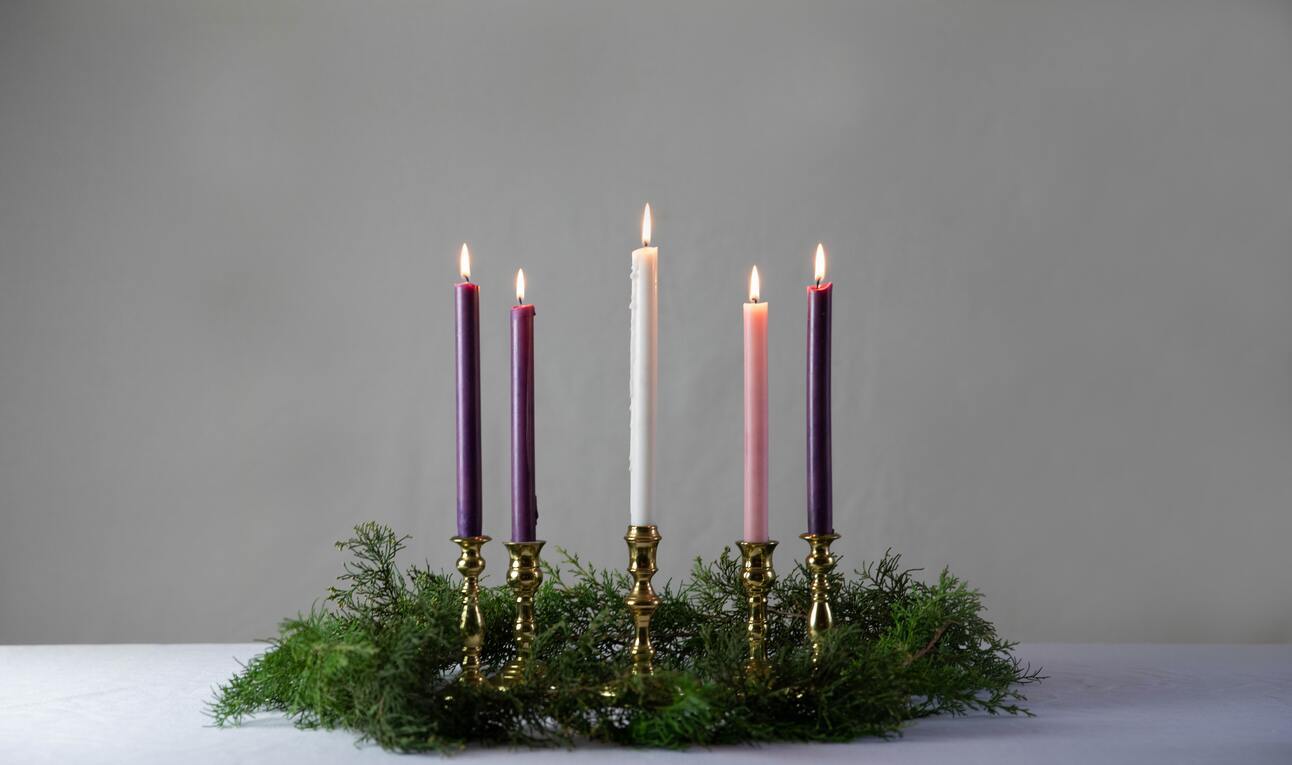While I was growing up, my family ate dinner together nearly every night. During Advent, we always had a wreath on the table, and lit the candles during dinner. For us, Advent was part of the preparation for Christmas.
Advent Means “Coming”
The word Advent means “coming.” It is the period of preparation for the celebration of Christ’s birth on Christmas. Advent begins on the fourth Sunday before Christmas and ends on Christmas Eve. Since the fifth century AD, Advent has been a time of prayer, reflection, and repentance.
During Advent, we identify with Old Testament Israel’s longing for the promised Messiah. We also rejoice in God’s fulfillment of that promise in sending his Son to be born in Bethlehem. Finally, we look forward to Christ’s return with longing and hope.
Origin of the Advent Wreath
One way to observe Advent is by using an Advent wreath. The modern Advent wreath can be traced back to a German Lutheran missionary working among the urban poor in the 19th century. He created a wreath out of an old wooden wheel to help the children in his orphanage understand how many days were left before Christmas. Churches in Germany and beyond began to adapt the advent wreath as part of their preparation for Christmas.
The Advent wreath has four candles, one for each Sunday before Christmas. On the first Sunday of Advent, the first candle is lit. On the second Sunday of Advent, two candles are lit, and so on. Sometimes a white candle, called the “Christ candle,” is placed in the center, and it is lit on Christmas Eve or Christmas Day.
The colors of the candles, at least in the U.S., are taken from the traditional colors of the vestments used in liturgical churches during Advent. Three of the candles are purple or blue, representing confession and repentance. The candle for the third Sunday is pink, representing joy. One traditional meaning for the four candles is: Prophecy, Bethlehem, Shepherds, and Angels. Another is Hope, Faith, Joy, and Peace. There are other variations and traditions.
When my children were young, my wife and I decided to use an Advent wreath to help teach our children about the true meaning of Christmas. Each Sunday during Advent we light the appropriate candle(s) and read a passage from Scripture. On Christmas Eve, we light all four candles plus the Christ candle. As the children became older, we invited them to help with lighting the candles and reading the passages.
Many Jewish families have traditions for Passover and other holidays that involve the whole family and help the children to understand their faith. Sometimes they have a script in which the oldest or youngest child lights a candle or asks a question, and the parents respond with an answer or a prayer. These simple ceremonies are an important part of passing on our faith to the next generation.
How to Observe Advent as a Family
To observe Advent as a family, you need to prepare two things: an Advent wreath and a plan for the candle lighting and readings.
The easiest way to obtain an Advent wreath is to buy one locally or online. Look for a wreath with three purple candles and one pink candle. Depending on how long you burn the candles each week, you might need some replacement candles. Get a white candle to put in the center as the Christ candle. If you want, you could buy the candles and make your own wreath from evergreen branches and pinecones. That could be a great family project!
There are many Advent readings available online. I like to include a reading from Old Testament prophecy about the Messiah and a reading from the Gospels each week. Rather than a devotional, I suggest that you stick with reading passages from the Bible.
For many families, the best time for the Advent ceremony each week is Sunday dinner. Here is a suggested outline:
- Get everything ready and gather around the table.
- One of the parents explains very briefly why you have the advent wreath and what it means.
- Explain the meaning of the candle for that week.
- Light the candle(s) for that week.
- Read the passages.
- The father or mother leads in a short prayer thanking God for sending his Son and giving thanks for your food.
- Discuss the passages while you eat dinner.
If you wish, you could have an Advent ceremony every day during Advent. In that case, each week you would continue lighting the candles from the previous Sunday. If you do this, you will need extra replacement candles. During the week you could simply give a 15-second explanation and light the candles, then read a short passage of Scripture. Keep it shorter than the Sunday ceremony so that Sundays are special.
More Suggestions:
- Involve your entire family in the ceremony, including preparation of the wreath, lighting candles, and reading the passages.
- Keep the ceremony short so that your children (and other adults!) do not lose focus and become impatient for their dinner.
- For safety, you should never leave a burning candle unattended.
So much of the Christmas season in our culture has nothing to do with Jesus. Family Advent provides one way to remind ourselves of the true meaning of Christmas and to pass our faith on to the next generation. Since Advent is not commanded in Scripture, we are free to modify our practices to suit our family situation. Be creative, and let’s focus on Jesus this Christmas season!

